Project Background
This project was carried out during the 2016 leatherback and green turtle nesting seasons in Tortuguero, Costa Rica. Financial supports from World Nomads customers through the Footprints Network provided essential resources to carry out a program with the following primary goals:
Goal #1: Monitor three sea turtle species nesting at Tortuguero and determine long-term population trends and survival threats.
Goal #2: Reduce human impacts on Tortuguero's sea turtles and the coastal and marine environments critical to the survival of these species.
Goal #3: Evaluate Tortuguero's community-based turtle tour system and implement reforms to ensure minimal negative impacts to nesting sea turtles.
Goal #4: Train aspiring biologists from the region in sea turtle monitoring and conservation techniques.
Goal #5: Implement an environmental education program for the local community and Tortuguero visitors.
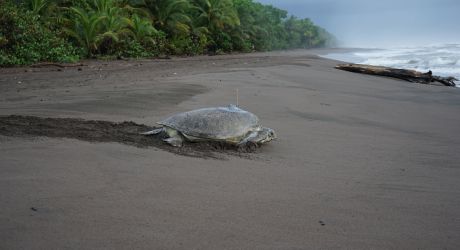
Key Project Outcomes
Goal #1
A rigorous research and monitoring program was carried out at the Tortuguero nesting beach throughout the leatherback and green turtle nesting seasons (hawksbills also nest sporadically during the year). The leatherback season ran from March – June and the green turtle season runs from June through December.
The 2016 Leatherback season showed that it was the least productive nesting season since monitoring began for this species at Tortuguero in 1995.
Extremely high tides continued this season, similar to last year, causing significant erosion of the coastline. Unfortunately, this level of erosion may be normal going into the future as this may be a consequence of climate change and sea level rise, which are supposed to worsen over the next 50-100 years.
During daytime track surveys of the entire 18 miles of beach, only 89 Leatherback nests were recorded, in contrast with the 180 of the 2015 season. This is in fact the lowest number of nests recorded since Leatherback numbers begun to be recorded in 1995. Given the level of erosion, it is likely that numerous turtle tracks and nests were washed away before STC could document the activity.
During nightly patrols, 11 nesting Leatherbacks were encountered, eight of which had tags from previous years. However, the tags found were applied at other beaches, mostly south of Tortuguero. One Leatherback nest was recorded as poached this year.
Although green turtle nesting at Tortuguero shows a general upward trend over the last 40 years, during the period of 2012-2015 there was an unexpected downward trend in nesting. Fortunately, in 2016 this decline has been reversed and with still a month left in the nesting season there have been nearly 40,000 nests documented in the northern section of the beach.
Goal #2
STC continued to reduce human impacts on Tortuguero’s sea turtles through the implementation of its annual monitoring program, which has been developed to facilitate an accurate evaluation of the impact of different threats and allows threat trends to be rapidly identified so that appropriate measures can be taken.
In 2016, the majority of threats were anthropogenic in nature, including illegal take of eggs and killing of nesting turtles on the beach. There were 88 green and two hawksbill nests poached in 2016 and 38 turned and dragged green turtles; of these, 21 were taken in a single night. Most of this poaching activity occurred inside the PNT.
Nest predation by dogs amounted to a total of 13 nests. Predation of adult turtles by jaguars during amounted to 11 green, three leatherbacks, and two hawksbill turtles. STC does not interfere with natural predation such as that being carried out by jaguars; however, we do work closely with the community to address dog predation by conducting spay and neutering programs and community outreach to encourage more responsible pet ownership. As a result of this work, dog predation has been steadily reducing in Tortuguero.

Goal #3
The local economy of Tortuguero depends heavily on ecotourism, which draws over 100,000 foreign visitors per year who want to observe sea turtles nesting. About 10 years ago, STC worked with Tortuguero National Park and other government authorities to implement a new system for controlling the large numbers of people who accompany local guides to observe turtle nesting at night.
The new system, called the Turtle Spotter Program, sends small numbers of turtle spotters (scouts) onto the beach, while tourists wait in staging areas off the beach. When a turtle is located near a staging area, the spotters signal to guides when it is safe to approach a turtle (usually once a turtle has started dropping its eggs). This process prevents numerous guides from simultaneously walking the beach with their groups at the same time – a situation that often resulted in disturbing emerging turtles. The new system has worked very well; however, in 2015 STC documented that many newer guides were ignoring the system and taking their groups on the beach without direction.
During 2016, at the request of Park authorities, STC stepped in to oversee the program once again. STC conducted a guide training program prior to the start of the green turtle nesting season and also conducted retraining for the turtle spotters. As hoped, compliance with the turtle-watch guidelines approached 100%, with no documented disturbances of turtles. The photo to the left shows a turtle guide with his group of North American and European tourists watching a green turtle complete the nesting process.
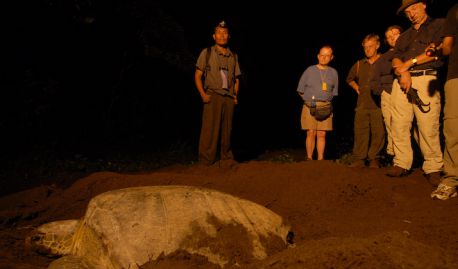
Goal #4
While STC carries out its monitoring and protection program at Tortuguero, the organization also seeks to continue building conservation capacity in Latin America and the Caribbean through a Research Assistant (RA) Program.
Because Tortuguero’s sea turtles migrate to the waters of countries throughout the Wider Caribbean and Atlantic, there is a need for international cooperation in any turtle conservation initiatives. Thus, capacity building through the training of professionals from many of these countries is needed urgently.
While in Tortuguero, the RAs receive hands-on training from STC’s experienced turtle biologists as they directly help implement the rigorous research protocol. The photo to the right shows a group of RAs learning the proper methods for measuring the carapace length of a nesting green turtle. The program is training tomorrow’s leaders in the fields of biological research and natural resource management. Many of the world’s top sea turtle biologists are alumni of the Tortuguero RA program.
A total of 29 people participated in the 2016 RA Programs, from 14 different countries (Canada, Chile, Colombia, Costa Rica, Venezuela, France, Mexico, Russia, Spain, Peru, UK and USA). Eight participants from Latin American countries were selected (28%), three more than last year; this is more than double the percentage from 2015, made possible in part by the funding provided by World Nomad’s Footprints Network, which allowed STC to support international travel and costs associated with the visa application process.
We plan to continue to maintain our recruiting efforts in the Latin American region to ensure effective capacity build up in Latin American countries.
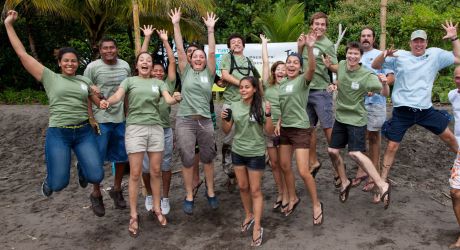
Goal #5
Environmental education within the community of Tortuguero is critical to the long-term protection and recovery of sea turtles. In 2016, two volunteer Education and Outreach Assistants (EOA) were selected to assist the Education and Outreach Coordinator (EOC) with development and implementation of a diverse program of activities focusing on sustainability, waste management and the importance of vegetation to the environment.
Over 150 activities were conducted with students at the kindergarten, school and high school. The photo below shows just one of the nearly daily interactions STC has with local school kids. In this photo, a group of elementary students came to STC’s library to work on an educational poster about some of the marine life found in Tortuguero. In recognition of STC’s education and outreach work, the ECO was also asked by the Ministry of Environment and Energy (MINAE) to be a member of a committee focused on environmental education in the Tortuguero Conservation Area.
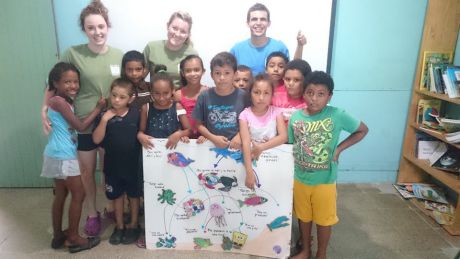
Some projects were initiated by the EOC in 2015 in collaboration with MINAE and other partners in Tortuguero and are still continued today, such as a community-wide program to reduce the use of plastic bags called “Desembolsate” (Shed Your Bags), which has raised funds to produce reusable bags that were distributed to households in Tortuguero, and an initiative to reduce artificial light pollution on the nesting beach, in conjunction with the Costa Rican Electricity Company. As a result of efforts by the STC we observed a significant reduction in the use of public turtle-impacting lights during the 2016 season. Hotel owners continue to collaborate with this important program.
What next?
The work at Tortuguero represents a long-term commitment by STC to monitor and protect this critical nesting beach in partnership with the local community. We foresee the program continuing indefinitely as we continue to protect and recover this globally important population of green turtles.
Can I visit this project?
Tortuguero, Costa Rica, is a world renowned destination for ecotourism and turtle-watching. STC operates a fully-functioning biological field station that regularly hosts up to 25 people. We would be happy to host World Nomads staff or clients on a visit to Tortuguero to observe and participate in the turtle research program.
Background on Current Situation
The 20-mile-long Tortuguero Beach, located on the north Caribbean coast of Costa Rica, hosts the largest green turtle rookery in the world, along with important populations of leatherback and hawksbill turtles. For over 55 years, Sea Turtle Conservancy has conducted an annual research and conservation program at Tortuguero, which has achieved phenomenal success—including a 600% increase in annual green turtle nesting. Despite this fantastic history of achievement, all three turtle species nesting at this site still face numerous threats. To ensure that efforts of the last five decades have not been in vain, STC must continuing it’s monitoring and conservation program, while addressing new threats to the sea turtle populations and their nesting habitat. STC’s focus has been to support sustainable eco-tourism that directly benefits the community and minimizes any harmful impacts on the turtle nesting colony.
Project Aims:
- Conserve and recover the sea turtle populations nesting at Tortuguero so that they fulfil their ecological roles.
- Build sea turtle conservation capacity throughout Latin American and the Caribbean through STC’s Research Assistantship Program.
- Provide leadership in addressing known and emerging threats to Tortuguero’s sea turtles.
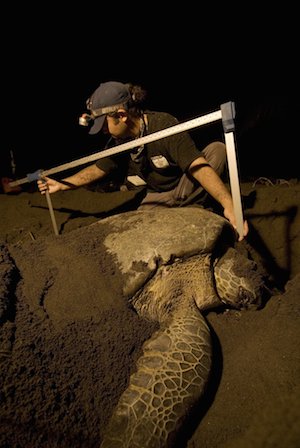
Project Objectives:
- Monitor three sea turtle species nesting at Tortuguero and determine long-term population trends and survival threats.
- Reduce human impacts on Tortuguero’s sea turtles and the coastal and marine environments critical to the survival of these species.
- Evaluate Tortuguero’s community-based turtle tour system and implement reforms to ensure minimal negative impacts to nesting sea turtles.
- Train aspiring biologists from the region in sea turtle monitoring and conservation techniques.
- Implement an environmental education program for the local community and Tortuguero visitors.
Project Outcomes:
- Three species of sea turtles benefit from investigation into population trends and survival threats.
- Twenty-four aspiring biologists will receive intensive practical hands-on experience in sea turtle research techniques.
- The community of Tortuguero will benefit from environmental education and outreach programs, and sustainable ecotourism supporting the local economy.
- At least 50,000 people will be reached through education activities at STC’s Visitor’s Center.
- Illegal take of turtles and nests at Tortuguero will be reduced.
- At least two green turtles will be tracked using satellite telemetry after nesting at Tortuguero and their migrations tracked online through STC’s website (www.conserveturtles.org).
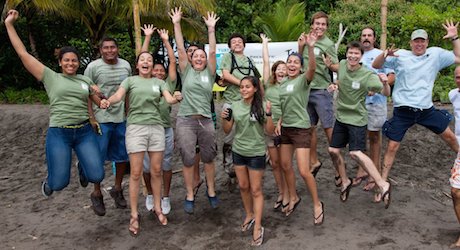
What is Covered in Project Costs
The budget for this project is $67,000. These costs include salaries for the project’s research coordinator, education coordinator and Visitor’s Center manager. The budget also includes research supplies and equipment, food for station staff and volunteers, gas for project boats, and supplies for community outreach and education activities.
Project Partners / Community Involvement
STC itself is one of the oldest institutions within the community of Tortuguero. When STC initiated its turtle monitoring and protection program in Tortuguero in the 1950s, there were just a handful of families living in the area. As the community has grown up around us, the organization has closely intertwined its activities with all community stakeholders. STC has worked hard to develop a good relationship with the public schools in Tortuguero, and leaders of the community. STC works closely with Costa Rica’s Ministry of Environment (MINAET), as well as park rangers who oversee Tortuguero National Park. STC also provides training each year to local nature tour guides, including information on basic sea turtle biology, nesting behavior, and best practices to reduce impacts of tourist activities on nesting turtles. STC is a guiding member of the Tortuguero Conservation Area Regional Council, which is comprised of representatives of NGOs, education centers and the private sector; the Council plays a key role in the administration and management decisions of the Tortuguero Conservation Area (ACTo), including many issues that directly impact sea turtle conservation. STC is an active member of the Costa Rican National Network of Sea Turtle Conservation Projects—attending meetings, providing technical advice and sharing information with other sea turtle conservationists in the country. Within Costa Rica and throughout Meso-America, STC shares its expertise and its data from Tortuguero with a wide array of NGOs and government bodies. As a member of the Consultative Committee of the Inter-American Convention for the Protection and Conservation of Marine Turtles, STC has been able to share critical information to guide this international sea turtle accord.
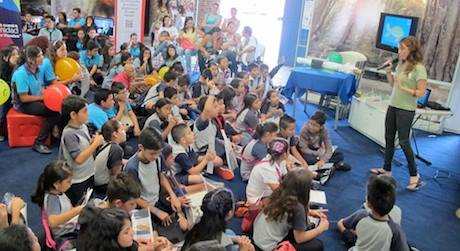
How this project fits into a larger strategy
For nearly 60 years, STC has conducted sea turtle research and protection on the Caribbean coast of Central America. This project fits well with the organization’s long-term strategies and goals for sea turtle recovery. In addition to the long-term program at Tortuguero, Costa Rica, since 2003 STC has operated a monitoring and protection program at Chiriqui Beach, Panama, aimed at recovering hawksbill turtles. The organization also carries out an annual program at Soropta Beach, Panama, that is protecting and recovering leatherbacks, which face considerable threats from poaching in the region.